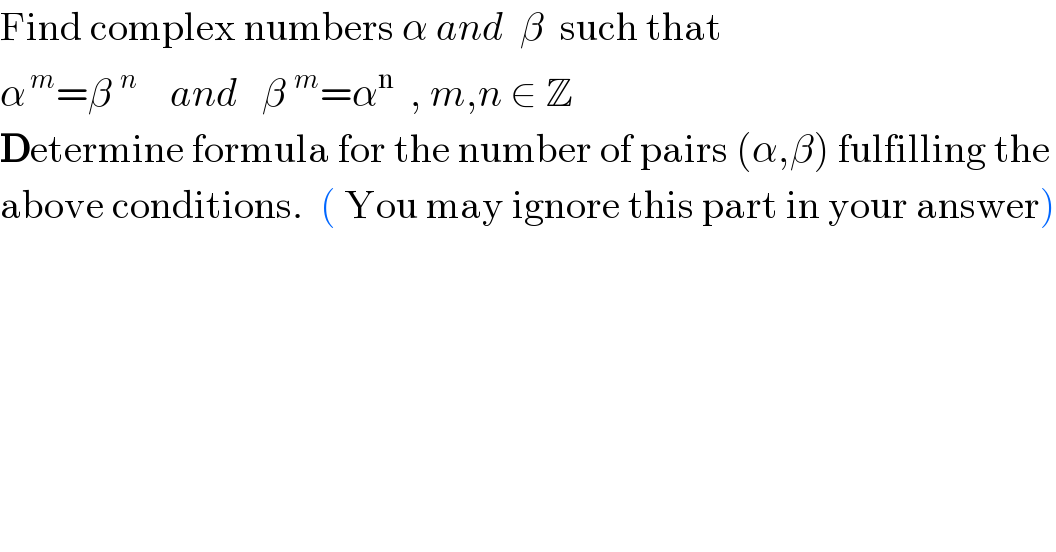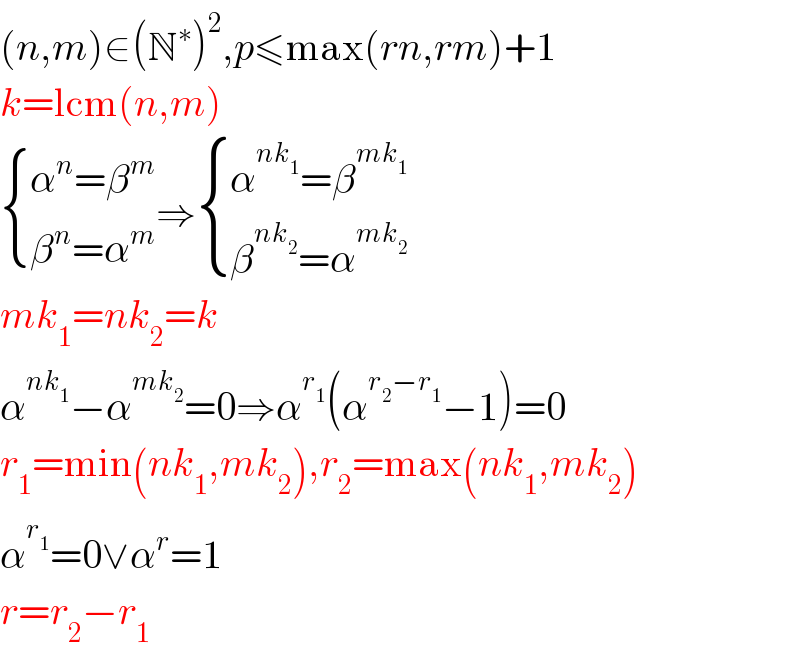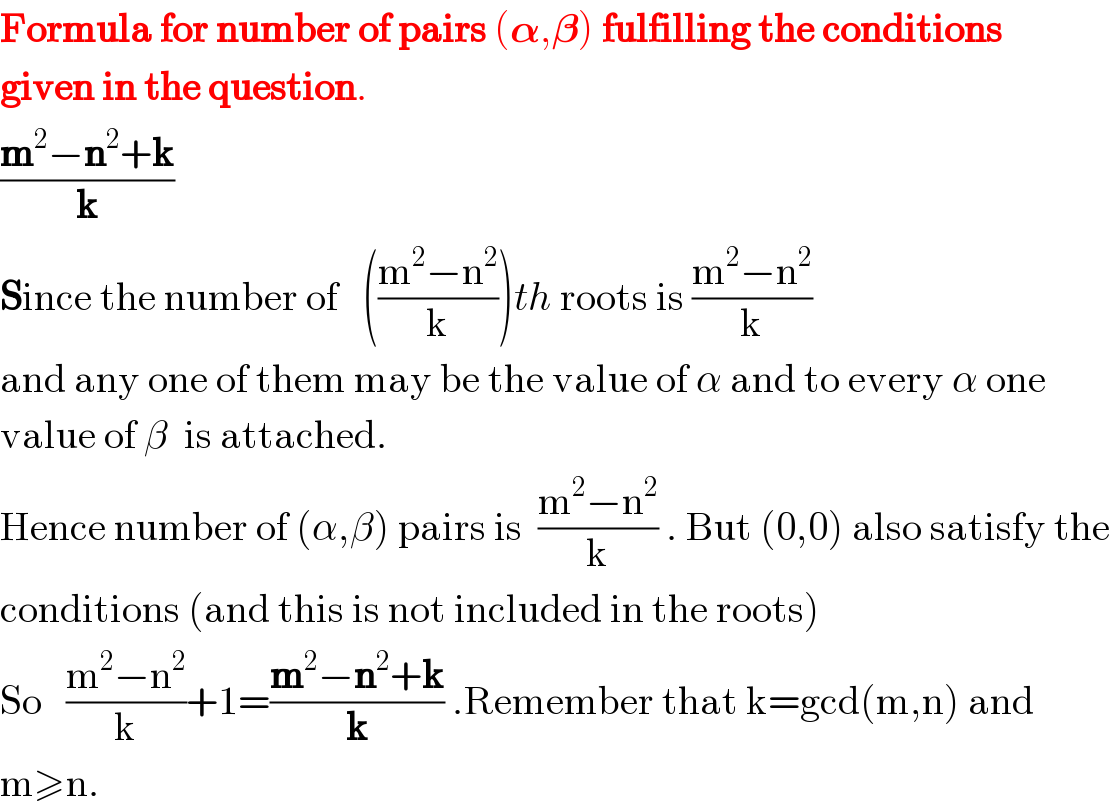Question Number 1498 by Rasheed Soomro last updated on 14/Aug/15

Commented by 123456 last updated on 14/Aug/15

Commented by Rasheed Ahmad last updated on 14/Aug/15

Commented by 123456 last updated on 15/Aug/15

Commented by Rasheed Ahmad last updated on 15/Aug/15

Commented by 123456 last updated on 15/Aug/15

Commented by Rasheed Soomro last updated on 15/Aug/15

Answered by Rasheed Soomro last updated on 17/Aug/15
![Let gcd(m,n)=k ⇒ lcm(m,n)=((mn)/k) α^m =β^( n) ⇒( α^m )^(m/k) =(β^( n) )^(m/k) ⇒ α^(m^2 /k) =β^((mn)/k) (I) β^( m) =α^( n) ⇒ (β^( m) )^(n/k) = (α^n )^(n/k) ⇒ β^((mn)/k) =α^(n^2 /k) (II) Our goal is to achieve β ′s common exponent ( of course least common exponent (((mn)/k) ) is suitable for simplified solution) in order to eliminate β in above steps. From (I) and (II) α^(m^2 /k) = α^(n^2 /k) As m and n are exchangeable here we may assume m≥n (If n>m then it will be merely matter of exchanging symbols) α^(m^2 /k) − α^(n^2 /k) =0 ⇒ α^(n^2 /k) ( α^((m^2 /k) − (n^2 /k)) − 1)=0 ⇒ α^(n^2 /k) = 0 ∨ α^((m^2 − n^2 )/k) =1 ⇒ α=0 ∨ α=^((m^2 − n^2 )/k) (√( 1)) (α is (((m^2 − n^2 )/k))th root of unity) α=0 ⇒β=0 [ No need to show process ] ∴ α is (((m^2 − n^2 )/k))th root of unity. Similarly it can be shown that, β is also (((m^2 − n^2 )/k))th root of unity. nth roots of unity are given by: ( cos ((2π)/n) +ı sin ((2π)/n) )^j j=0,1,2,....,n−1 Hence, (((m^2 − n^2 )/k)) th roots of unity will be: ( cos ((2πk)/(m^2 −n^2 )) +ı sin ((2πk)/(m^2 −n^2 )) )^j j=0,1,2,...(.((m^2 − n^2 )/k) −1) Let cos ((2πk)/(m^2 −n^2 )) +ı sin ((2πk)/(m^2 −n^2 )) =ω (((m^2 − n^2 )/k)) th roots of unity=1,ω,ω^2 ,......,ω^((m^2 − n^2 −k)/k) [ Let ((m^2 −n^2 )/k) = N ] mth power of ∽ =1, ω^( m(mod N)) ,ω^( 2m(mod N)) ,...ω^( m(N−1)(mod N)) nth power of ∽ =1, ω^( n(mod N)) ,ω^( 2n(mod N)) ,...ω^( n(N−1)(mod N)) Let j_1 , j_2 =0,1,2,...(.((m^2 − n^2 )/k) −1) Let α = ω^( j_1 ) and β = ω^( j_2 ) are two Nth roots such that α^m =β^( n) ⇒ ω^( mj_1 (mod N)) =ω^( nj_2 (mod N)) ⇒mj_1 (mod N)=nj_2 (mod N) α^n =β^( m) ⇒ ω^( nj_1 (mod N)) =ω^( mj_2 (mod N)) ⇒nj_1 (mod N)=mj_2 (mod N) Therefore −−−−−−−−−−−−−−−−−−−−−−−−− For mj_1 (mod ((m^2 −n^2 )/k) )=nj_2 (mod ((m^2 −n^2 )/k) ) and nj_1 (mod ((m^2 −n^2 )/k) )=mj_2 (mod ((m^2 −n^2 )/k) ) ( α, β)=(ω^j_1 , ω^j_2 )=(ω^j_2 , ω^j_1 ) where ω is (((m^2 − n^2 )/k)) th root of unity( with m≥n).](https://www.tinkutara.com/question/Q1533.png)
Answered by Rasheed Soomro last updated on 17/Aug/15

Commented by Rasheed Soomro last updated on 20/Aug/15

